Dear extending thinkers,
Nobody doubts that we can dig faster with a shovel than with our naked hands, see further with binoculars than with our naked eyes, and travel further by taking a plane than by walking. All these are clear examples of extending our senses and our motor functions. Still, we are trusting our naked minds much too much, and it’s time to also extend our minds!
In this module we will learn, experiment and play with three robust, well-proven and empowering mind-extension tools. These are the Getting Things Done method, Outlining and the Theory of Constraints.
If you do already know or practice one or several of them, it will also be a great occasion to revive them, go deeper and discuss them.
Task 1 – Emptying your mind
Being stressed, overloaded and distracted can only have negative effects on your productivity and thinking. Having a clear and empty mind is the foundation for good thinking. So your first task is simply to empty your mind. David Allen, the author of the book and method “Getting Things Done” (GTD) calls this a “mindsweep”.
The task is simple. First, disconnect from any source of information. Then take a notepad (or a pile of postits), and each time you have a thought, emotion, to do, etc. just write it down. At this point, do not look back at what you wrote, do not try to think more about each item. You can use one page per thought/idea to avoid being distracted by your own thoughts. You can have duplicates. Take the time to do this until you have no new items coming up. The whole process can take from 20 minutes to several hours depending on how much of your mental memory you need to empty.
Be persistent, it’s important to go to the bottom of it to have the main benefit: a unique sense of relief.
Task 2 – Organizing your extended mind
Now, what do you do with all this stuff? You might notice that some items come again and again, or may be about the same topic. If things came back to your extended mind, it’s likely that they are important and/or urgent, and that you should deal with them.
Now, we will clarify and reduce the complexity of your external mindsweep by organizing it. Generally, it’s a good idea to use your favorite tool (digital or paper) to organize. But here we will focus on a process called outlining. It is the practice of breaking down and arranging ideas in a hierarchical way. Outlining is also called “idea processing” because you can re-arrange your structure easily and as much as you want, until you are satisfied with it. So it’s a very dynamical process. Many professional writers in fiction and non-fiction outline their stories and ideas. In other words, outlining is about creating a detailed table of contents before you actually write.
The philosophy of extended mind is a lot about the tools you use, so choosing the right tool is important. Which outliner software should you use? Word processors or note-taking applications most often have an outlining function (just look for it!), although it’s not always very user-friendly. For Mac users, I can recommend “Omnioutliner”, but for all other platforms for now, and for our purposes, I suggest we use an online solution called www.checkvist.com.
After you create an account, you can import the “OPML” file in checkvist available here.
If this sounds too nerdy and complicated, you can also open it in your Word processor and choose “View/Outline”: doc file.
Now, take all the items, one by one, all the “stuff” you had in Task 1, and begin to organize it in your outline. The detailed process of clarifying and organizing is described in David Allen’s (2015) book, but you can also follow the diagram of Fig.1 in my paper with Francis Heylighen (2008) on GTD (see bibliography below).
It’s important that you experiment creating several levels, increasing and decreasing indents, expanding and collapsing your outline depending on whether you want to focus on details or on the whole. Do play with your outline and move items until you’re satisfied!
Optionally, you can try to outline not only your to do list, but a set of ideas that you have for a report, a letter, a story, etc. You don’t have to share your resulting to do list with me (but you may share some parts of it if you like). Instead, please write me how it went for you, what is still not clear to you, what you like (or dislike) about outlining.
Task 3 – Reasoning with your extended mind
The capacity of problem-solving is a keystone if not a definition of intelligence. But how do we solve or approach the complex problems we are facing today? Instead of keeping complicated reasoning inside our heads, which by now you know is impossible because of the limitation of our brains, we need to put our reasoning outside our heads, making explicit the assumptions, causal relationships and logic we often use implicitly.
The capacity of problem-solving is a keystone if not a definition of intelligence. But how do we solve or approach the complex problems we are facing today? Instead of keeping complicated reasoning inside our heads, which by now you know is impossible because of the limitation of our brains, we need to put our reasoning outside our heads, making explicit the assumptions, causal relationships and logic we often use implicitly.
A great tool for doing this is the Theory of Constraints (ToC). A nice short introduction to ToC is in this document.
You can read the introduction first.
Now, let’s take an example you know well, and please do map visually with entities and their connections the reasoning that Jean-Paul Van Bendegem proposed you earlier:
“As everyone knows, when it rains or it snows, then, if you are not careful on the road, your car might behave funny. Really? But look, it is raining and my car behaves normal. Well, that only means that you are careful on the road, doesn’t it? Right! But I am not really sure if the same goes when it snows. Now, there you’re wrong, the conclusion does remain the case. Huh? And what if the sun shines?”
Feel free to write down several versions if you think there are ambiguities.
There is no need to use a specialized software like Flying Logic, you can just use a pencil and an eraser.
Then ask yourself the following questions:
- Is the diagram in its details and whole clear?
- Is every entity here? Or is there something absent?
- Does every link represent a valid causation?
- Could there be other items causing the results of reasoning?
- What additional effects could we expect from the situation?
In the ToC jargon, these are called the “categories of legitimate reservation”. See pages 19-28 of the same document.
Please do share with me the resulting diagram, you can just take a photo with your smartphone, and please also do bring your diagram on Dec 5th. Optionally, try to draw a diagram for a (personal or professional) current problem situation you’re dealing with.
To sum up, please send me by email (contact@clemvidal.com) for Dec 1St at the latest your impressions on the mindsweep (task 1), your questions about organizing your items, about outlining (task 2) and a picture of a diagram (or diagrams) of the reasoning above (task 3).
I wish you all a great time extending your thinking!
Clément Vidal.
***
Bibliography
Task 1: Getting things done
On the Getting Things Done, the main book is:
- Allen, David. 2015. Getting Things Done: The Art of Stress-Free Productivity. New York, NY: Penguin Books.
Here is a paper I co-wrote with Francis Heylighen explaining why GTD works so well. The section “The GTD method: summary” is a good start to get acquainted with it:
- Heylighen, F., and C. Vidal. 2008. “Getting Things Done: The Science behind Stress-Free Productivity.” Long Range Planning 41 (6): 585–605. doi:10.1016/j.lrp.2008.09.004. http://cogprints.org/6289/.
Task 2: Outlining
There is surprisingly little literature on outlining. Here is some basic information that Francis Heylighen wrote:
This blog is quite interesting about outlining, and discusses the tools:
You can also find educational videos on youtube by typing “outlining”.
Task 3: Theory of Constraints
The introduction I recommend is:
- McNally, Robert. 2016. “Thinking with Flying Logic.” http://flyinglogic.com/docs/Thinking%20with%20Flying%20Logic.pdf.
An accessible book is:
- Scheinkopf, Lisa J. 1999. Thinking for a Change: Putting the ToC Thinking Processes to Use. St. Lucie Press/APICS Series on Constraints Management. Boca Raton, FL: St. Lucie Press.
To go deeper:
- Dettmer, H. William. 1997. Goldratt’s Theory of Constraints: A Systems Approach to Continuous Improvement. Milwaukee, Wis: ASQC Quality Press.
(and other books by Dettmer).


